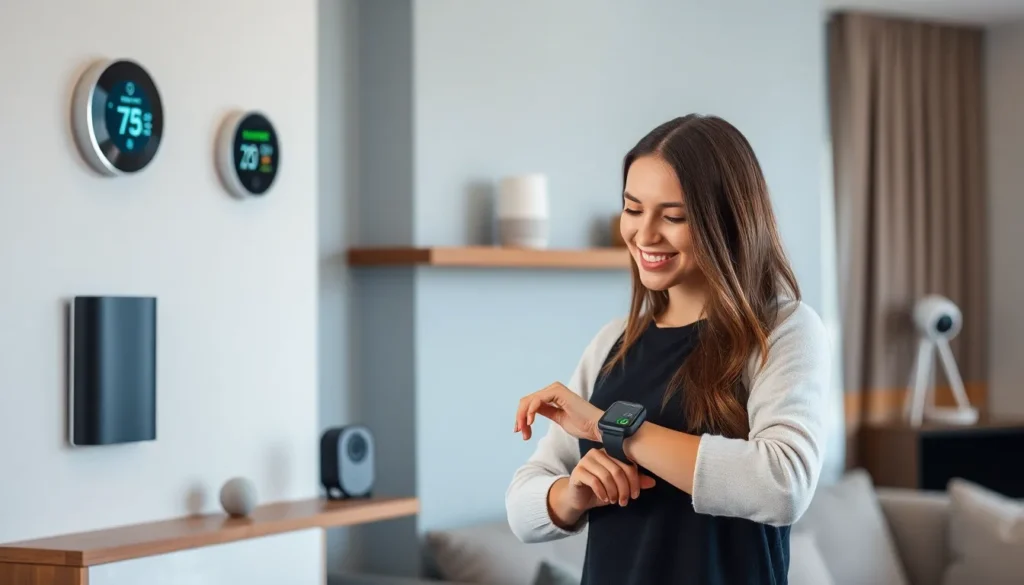In today’s fast-paced world, technology is like that friend who shows up uninvited but somehow makes everything more interesting. From waking up to a chirping alarm that’s probably more annoying than a rooster at dawn to navigating life with a smartphone that doubles as a mini-computer, tech is woven into the fabric of our daily lives.
Table of Contents
ToggleOverview of Technology in Daily Life
Technology plays a crucial role in daily life, enhancing convenience and efficiency. Devices such as smartphones allow for immediate communication and access to information. Many people rely on applications for navigation, streamlining their travel experiences. Smart home devices, including thermostats and security systems, offer increased control and safety in living environments.
Innovations in technology also simplify tasks, from grocery shopping through online services to managing finances via mobile banking apps. Instant connectivity via social media platforms helps maintain relationships, regardless of geographical barriers. Educational resources like e-learning platforms provide opportunities for continuous learning, adapting to various lifestyles.
Wearables, such as fitness trackers and smartwatches, promote health awareness by monitoring physical activity and vital signs. Entertainment options have expanded, thanks to streaming services offering on-demand content tailored to individual preferences. Moreover, advancements in healthcare technology improve diagnostic accuracy and patient outcomes.
Through these integrations, technology influences routines and behaviors significantly. Recent studies indicate that 72% of individuals use technology daily for work-related tasks, underscoring its importance in modern professions. Every interaction with technology contributes to a more interconnected and efficient world, shaping personal and professional lives alike.
Communication Advancements
Technology reshapes communication in various ways, simplifying interactions and keeping people connected.
Social Media
Social media platforms serve as vital tools for connection in daily life. Users share experiences, news, and ideas instantly with friends and family. Recent studies show that 54% of social media users engage with these platforms daily, highlighting their role in maintaining relationships. Applications like Facebook, Instagram, and Twitter allow for real-time updates and interactions among individuals across different locations. Businesses utilize social media for marketing, reaching broader audiences, and providing customer service. Community-building occurs through groups and discussions, fostering support networks that may span the globe.
Instant Messaging
Instant messaging applications revolutionize how people communicate. Services like WhatsApp, Facebook Messenger, and Telegram enable instant text exchanges, enhancing connectivity. Approximately 80% of smartphone users rely on instant messaging for both personal and professional conversations. These platforms provide features like voice and video calls, making interactions more versatile. Group chats enhance collaboration, allowing teams to discuss projects efficiently. Multimedia sharing through these apps enriches conversations with photos, videos, and documents, facilitating seamless communication among users without barriers.
Home Automation
Home automation technologies simplify daily tasks while enhancing comfort and security. These innovations prioritize convenience in various aspects of life.
Smart Devices
Smart devices play a central role in home automation. Connected gadgets like thermostats, lights, and security systems improve daily living. Devices such as the Google Nest and Philips Hue make it easy to control home environments remotely. Users can adjust settings via smartphones or voice commands, providing seamless multitasking. Integration with smart assistants like Amazon Alexa streamlines operations across different devices. Statistics reveal that around 67% of households use at least one smart device, reflecting the growing reliance on this technology. New users find it easy to adopt smart devices, given their user-friendly interfaces.
Energy Management
Energy management solutions in home automation offer significant savings. Smart thermostats such as Ecobee adjust heating and cooling based on occupancy patterns, reducing energy consumption. Monitoring energy usage through smart plugs allows homeowners to identify inefficiencies quickly. Data shows that homes with energy management systems can save up to 30% on utility bills. Homeowners appreciate automatic scheduling for devices, which helps optimize electricity usage. Furthermore, solar energy systems can integrate with these tools for enhanced sustainability, allowing for smarter energy decisions. Automated routines continually maximize energy efficiency while maintaining comfort.
Health and Fitness
Technology significantly influences health and fitness routines, enhancing how individuals monitor their well-being. Various applications allow users to track diet, exercise, and sleep patterns effectively.
Health Monitoring Apps
Health monitoring apps play a crucial role in daily health management. Many users leverage these apps to log food intake and count calories, making informed dietary choices easier. Exercise tracking features record activities and progress, helping users stay motivated. Wearable devices complement these apps by providing real-time data on heart rate, step count, and sleep quality. According to research, 50% of health app users found increased motivation to reach fitness goals. This combination of technology and health awareness drives individuals toward healthier lifestyles.
Telemedicine
Telemedicine transforms how individuals access healthcare services. Patients now consult healthcare providers through video calls, reducing the need for in-person visits. Convenient access enables timely consultations and referrals without travel. Statistics show that approximately 75% of patients appreciate the time saved through telehealth services. This approach proves particularly beneficial for managing chronic conditions, as regular check-ins monitor health status effectively. Overall, telemedicine enhances healthcare access and efficiency, aligning with modern technology trends.
Education and Learning
Technology significantly enhances education and learning experiences. Online platforms make it easy to access quality courses anytime.
Online Courses
Many individuals turn to online courses for flexible learning opportunities. Websites like Coursera and Udemy offer a wide array of subjects. Students enjoy the convenience of studying at their own pace, with 70% of learners preferring online education for its accessibility. Certificates obtained from these programs often increase job prospects and skill sets. In addition, real-time interaction through forums allows learners to engage with peers and instructors. This interactive element promotes deeper understanding and knowledge retention. Overall, online courses represent a modern solution for continued education.
Educational Apps
Numerous educational apps make learning more interactive and engaging. These applications target various age groups and subjects, offering tailored content. For instance, platforms like Duolingo and Khan Academy provide personalized learning experiences. Reports indicate that 65% of students use educational apps to enhance their studies. Features like quizzes, flashcards, and video lessons keep learners interested and motivated. Additionally, gamification elements in these apps foster healthy competition and boost retention rates. Therefore, educational apps prove essential tools in modern learning environments.
Transportation Innovations
Technology transforms transportation, making travel more efficient and accessible. Innovations like ride-sharing services and navigation apps illustrate this evolution.
Ride-Sharing Services
Ride-sharing services like Uber and Lyft revolutionized how people commute. Offering convenience and affordability, these platforms enable users to book rides with just a few taps on their smartphones. Approximately 30% of adults in urban areas use ride-sharing for their daily transportation needs. Increased connectivity facilitates ride-sharing by reducing wait times and enhancing safety, allowing users to track their drivers in real-time. Financially, many users find ride-sharing more cost-effective compared to traditional taxis, especially during peak hours.
Navigation Apps
Navigation apps, such as Google Maps and Waze, optimize travel routes significantly. These applications provide real-time traffic updates, helping users avoid congestion and reach destinations faster. Around 85% of smartphone users rely on such apps for directions. Features like estimated arrival times and alternative routes enhance travel planning. Users also benefit from community-driven updates, alerting them to accidents or road closures. The integration of voice commands makes navigating hands-free, promoting safer driving. Additionally, public transit options within these apps encourage more sustainable travel choices.
Technology’s impact on daily life is undeniable. It enhances convenience and efficiency across various aspects, from communication to healthcare. As individuals embrace smart devices and online platforms, they’re not just adapting but thriving in an interconnected world. The continual evolution of technology promises even greater advancements, shaping the way people live, work, and interact. Embracing these innovations can lead to improved productivity and a more enriched lifestyle. As technology continues to evolve, its role in shaping daily experiences will only grow more significant.









